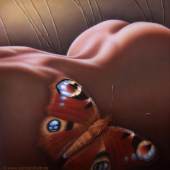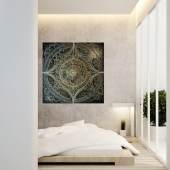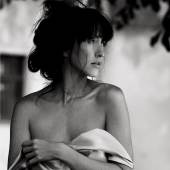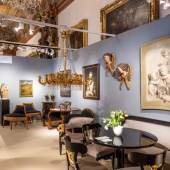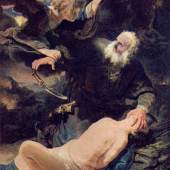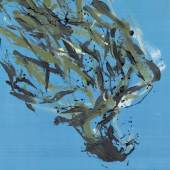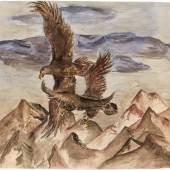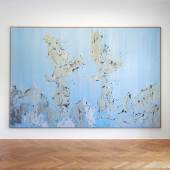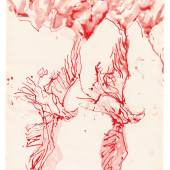Salzburg Villa Kast
Georg Baselitz adler barfuß
-
Ausstellung18.05.2024 - 20.07.2025
Created in the artist’s studio north of Salzburg, this new series of paintings and ink drawings features eagles – a motif that has resurfaced in Georg Baselitz’s oeuvre throughout his life. Depicted in tactile, multicoloured impasto, the eagles are rendered larger than life in gestural strokes, hovering in undefined spaces. Against varying backgrounds of blue, Baselitz uses spatulas rather than paint brushes to articulate the forms of the eagles, perched or in flight, producing marks that convey a sense of the vigour with which they were painted.
In Baselitz’s pictures the eagles are fully awake, as if electrified by painting that is wholly present, as if the bird had only just, in this very moment, materialised on the canvas – primed in a bleu céleste that is just as reminiscent of the backgrounds against which Lucas Cranach the Elder captured Saxon ladies, Prussian margraves or Philipp Melanchthon, Martin Luther and Katharina von Bora, as it is of the sky blue of the beach paintings that Pablo Picasso created in Dinard, in Brittany, in the 1920s. — Andreas Zimmermann
In two paintings, Baselitz depicts birds against a lighter, slate blue backdrop, grounded by a web of coloured streaks that stretches across the canvas in zigzagging lines. The eagles in these works prominently feature applications of cut-out plastic circles as eyes – a method that Baselitz has only recently adopted and which was inspired by Hannah Höch’s collages.
The two largest works in the exhibition each show a pair of birds in flight on a monumental scale, their wings spread almost 3 metres wide across the canvas. The birds are depicted against a mountain range and thereby directly refer back to the artist’s first ever rendition of the subject. Painted at the young age of 15, when he still went by Hans-Georg Kern, one of Baselitz's earliest works shows two eagles in flight over mountains and, as Zimmermann observes, ‘the importance Baselitz attaches to this early work, done when he was still a schoolboy, is evident from the fact that over the decades he has repeatedly returned to it.’
Baselitz’s works can almost always be tied to his experiences and impressions during his childhood in Dresden and the ensuing formative years he spent in Berlin. By revisiting the motifs of his past, Baselitz offers a reflection on the significance of painting itself. Asked about this self-referentiality, he stated: ‘I kept sinking into myself, and everything I do is being pulled out of myself.’
Since the 1960s, Baselitz has consistently renewed his practice through innovative formal developments, often responding to art history and his own extensive oeuvre. While Baselitz’s painting technique has been subject to constant transformation, his thematic vocabulary revolves around a number of key subjects that run through his oeuvre like a thread and notably include his wife, Elke.
The return to the highly symbolic motif of the eagle integrates a wide range of historical and art-historical references into his work, including Rembrandt’s iconic depiction of Ganymede in the collection of the Gemäldegalerie Alte Meister in Dresden, which Baselitz was familiar with from a young age. ‘The eagle embodies qualities that have fuelled the human imagination for thousands of years,’ writes Zimmermann, and its great significance as a heraldic symbol in German history further plays into the backdrop of Baselitz’s repeated examination of this subject.
The sculptural series Dresdner Frauen (Women of Dresden) references Baselitz’s upbringing in post-war Germany. The 13 female heads are not portraits in the traditional sense but pay tribute to the so-called Trümmerfrauen, which literally translates to 'rubble women'. These women helped clear and reconstruct Germany's bombed cities in the aftermath of the war and played a crucial role in the country’s reconstruction. Monumental in scale, Baselitz’s sculptures pay tribute to the women’s achievements. Deeply impacted by the annihilative bombing of the city in 1945, Baselitz here manifests the simultaneous trauma, resilience and recovery that the city has come to symbolise in the post-war era.
About the artist
Georg Baselitz, who has worked with the gallery for over 20 years, lives between Lake Ammersee in Bavaria, Salzburg, and Imperia in Liguria, Italy. He has had a profound influence on international art since 1980, shaping a new identity for German art in the second half of the 20th century; in reaction to the trauma and tragedy of the Second World War, he developed an artistic vocabulary which draws on the work of his forebears, whilst remaining unique and wholly individual. Since then, Baselitz has consistently renewed his practice through formal developments, often responding to art history and his own extensive oeuvre to develop his central themes through an ever-evolving, yet distinct, mode of artistic expression.
-
27.07.2021 - 31.07.2021Mit dem GALLERY WEEK_END 2021 erhält die Kulturszene Salzburgs ein neues Veranstaltungs-format,...
-
23.03.2024 - 01.04.2024Die Messe für Kunst, Antiquitäten und Design gehört zum österlichen Salzburg wie die Palmbuschen...
-
14.10.2022 - 16.10.2022Im Messezentrum Salzburg laufen die Aufbauarbeiten für die 18. Auflage der Internationalen...
-
Die Stadt Salzburg setzt mit dieser Stadtgalerie einen dezentralen Kulturschwerpunkt und...
-
Laut dem Kunstmarkthistoriker Gerald Reitinger (1970), gehörte Rembrandt zu den...
-
18.05.2024 - 20.07.2025Created in the artist’s studio north of Salzburg, this new series of paintings and ink...
-
21.12.2024 - 01.03.2025Diese Ausstellung präsentiert eine Auswahl von Skulpturen Hans Josephsohns (1920–2012), die...
-
11.01.2025 - 22.02.2025The exhibition Sculpture Nails at Thaddaeus Ropac Paris Marais highlights Sylvie Fleury’s...
-
25.01.2025 - 05.04.2025Anlässlich seines 95. Geburtstags präsentiert die Ausstellung zwei bedeutende Werkserien Arnulf...
-
18.05.2024 - 20.07.2025
Tuesday—Saturday, 10am—6pm.
